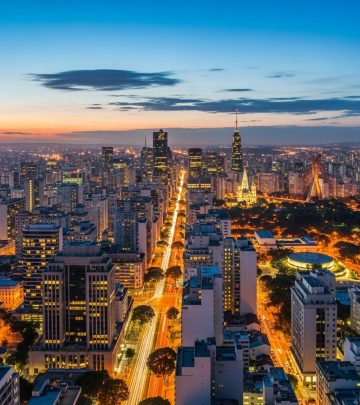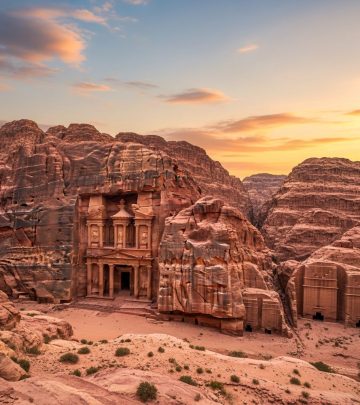Farview Point: Bryce Canyon’s Window to the Infinite Southwest
Marvel at Farview Point—unbeatable panoramic vistas, manageable access, and a slice of the park’s unique geology all in a single stop.

Farview Point: Gateway to Bryce Canyon’s Boundless Horizons
Set on the southern sweep of Bryce Canyon National Park, Farview Point delivers what its name promises—a vantage atop the Paunsaugunt Plateau where visitors can savor immense vistas, vibrant geology, and the extraordinary clarity for which this park is known. Whether you’re a road tripper taking the Southern Scenic Drive, a photographer chasing morning’s golden glow, or a nature enthusiast seeking Bryce’s signature landscape, Farview Point is a destination and an experience rolled into one.
Location & Access: Getting to Farview Point
Farview Point is located at mile 10.25 of the park’s iconic 18-mile Southern Scenic Drive (Utah State Route 63)—roughly 10 to 10.5 miles south of the park entrance and Visitor Center. The overlook sits at an impressive elevation of 8,819 feet (2,688 meters) above sea level, perched on the rim of the Bryce Amphitheater. Parking is provided in a spacious lot with basic amenities, including restrooms, trash and recycling bins, bicycle racks, and picnic tables, making for a leisurely stop even for groups and families.
- GPS Coordinates: 37.544551, -112.247115
- Route Type: Overlook (minimal walking required)
- Difficulty: Easy; paved and wheelchair accessible to the main overlook
- Accessibility: No park shuttle service—visitors must arrive by car; the Rainbow Bus Tour offers limited access twice daily by reservation
Why Farview Point Stands Out
The defining feature of Farview Point is its extraordinary ability to place the vast, layered terrain of the American Southwest in your field of vision. On a clear day, vistas extend for 90 miles or more—from the dusky slopes of Navajo Mountain to the mesas of Arizona, the Henry Mountains, Aquarius Plateau, Kaiparowits Plateau, and even the stark white cliffs of Molly’s Nipple. The breadth of this panorama is unrivaled within the park and owes much to Bryce Canyon’s pristine air quality. The scarcity of haze and air pollution is not an accident but a fiercely protected asset, rewarding visitors with views almost untouched by atmospheric obstruction.
- Grand Staircase-Escalante National Monument—visible as a series of colorful rock layers stretching southward
- Kaiparowits Plateau—sandstone highlands sweeping the horizon
- Henry Mountains—an isolated range, striking against the blue
- Navajo Mountain—a sacred Navajo landmark, looming 90 miles away
- Dixie National Forest—forestlands merging with Bryce’s unique topography
Main Attractions at Farview Point
- Deep Panoramas: See for dozens of miles over multiple states, with the banded geology of the Colorado Plateau on full display.
- Colorful Hoodoos: View the famous spires for which Bryce is renowned, glowing red, orange, and ochre at different times of day.
- Piracy Point: A quick 300-meter (about 1000 feet) stroll north along the rim leads to this secondary overlook. It grants a fresh perspective and a whimsical butte formation allegedly resembling two pirate ships locked in battle.
- Natural Bridge: Further along the drive, beyond Farview, this immense natural arch provides a dramatic photo opportunity and insight into Bryce’s erosive forces.
- Stargazing: As a designated International Dark Sky Park, Bryce offers exceptional night skies. Farview’s southern exposure and sparse crowds after sunset make it a serene place for night photography or amateur astronomy.
Experiencing the View: What to Look For
Farview Point is an interpretive stop where geology, ecology, history, and pure visual splendor unite. Here are standout features and scenes to savor:
- The Grand Staircase: A sequence of vividly colored rock layers stepping down to the Arizona Strip, the perfect demonstration of the region’s geological story.
- Pink Cliffs: The uppermost platform in the Grand Staircase, brilliant in the dawn light.
- Molly’s Nipple: The arresting white mesa distinct on the horizon.
- Kaiparowits Plateau: A vast, remote wilderness that seems endless from above.
- Dawn and Sunrise: The interplay of light and shadow at daybreak, when the hoodoos ignite in neon hues, is often cited by visitors as unforgettable.
Visitor Experience & Facilities
Farview Point is designed to blend utility and preservation. The paved main overlook is a brief, accessible walk from the parking area. For those seeking a new angle, the Piracy Point Trail offers an easy, mostly level path along the canyon rim to a quieter, slightly elevated platform. While services are basic (restrooms, trash, recycling), the site is generally uncrowded outside midsummer and sunrise/sunset peaks.
| Feature | Details |
|---|---|
| Parking | Adequate, well-marked lot (note: fills quickly at sunrise) |
| Restrooms | Available—basic, well-maintained |
| Accessibility | Main overlook is paved and wheelchair-accessible; Piracy Point path is unpaved but level (manageable in dry conditions) |
| Picnic Area | Several tables available for use |
| Shuttle Access | No regular park shuttle; Rainbow Bus tour available by reservation |
Piracy Point: The ‘Secret’ Twin of Farview
Just a 0.2-mile (300m) walk north from Farview’s main parking lot, Piracy Point offers a quieter overlook hovering above hoodoo formations said to look like dueling galleons. This spot is rarely crowded, with more intimate views of canyon buttes. The path is generally level, though unpaved; sturdy shoes are a good idea, especially if conditions are wet or muddy.
Top Tips for Visiting Farview Point
- Best Time to Visit: Arrive at sunrise for magical light, cooler temperatures, and fewer crowds. Early morning also enhances the vibrant colors of the hoodoos and rock formations.
- Road Conditions: The Southern Scenic Drive can experience closures, especially during winter months. Always check park alerts before your journey.
- Footwear: Even for short walks, wear sturdy shoes—rocky and sometimes muddy surfaces are possible.
- Picnics: Utilize available tables, but leave no trace—pack out all trash.
- Seasonality: The high elevation means cooler temperatures, sudden weather changes, and snow possible as late as May or June. Dress in layers year-round.
- No Shuttle Service: Plan your own transportation; Farview Point is car-access only except for reserved Rainbow Bus tours.
Naturescape: Flora and Fauna Around Farview
The boundary region around Farview Point straddles zones of Ponderosa pine forests and spruce-fir stands, creating habitats for unique plant and animal communities:
- Plants: Look for goldeneye, shrubby cinquefoil, and an array of high-altitude wildflowers in spring and summer.
- Birdlife: Spot osprey gliding the currents, ravens, and various songbirds.
- Mammals: The threatened Utah Prairie Dog sometimes emerges from burrows nearby; keep a respectful distance if you spot one.
- Reptiles: Lizards bask on sun-warmed rocks; beware of the area’s higher elevation as cool spells are common even in summer.
Trails and Hikes: Notable Walks from Farview
- Piracy Point Trail: 0.2 miles (300 meters), easy; leads to an additional overlook northward along the rim.
- Whiteman Connecting Trail: 0.9 miles; connects to further trail networks for longer forays.
- Sheep Creek Trail: 10 miles; a longer backcountry option for those seeking solitude and immersion in the park’s wilder areas.
- Swamp Canyon Trail: About 1 mile; offers access to more secluded canyon landscapes nearby.
Proximity to Other Bryce Canyon Highlights
- Natural Bridge: Just past Farview Point, an impressive natural arch sculpted by erosive forces awaits photography fans and geology buffs.
- Inspiration Point: A celebrated amphitheater-view overlook further north, best at sunrise for vivid hoodoo hues.
- Rainbow & Yovimpa Points: The southern terminus of the Scenic Drive, each providing even more dramatic perspectives over the canyon’s ever-expanding scenery.
Stargazing: Nighttime Magic at Farview Point
Thanks to Bryce Canyon’s status as an International Dark Sky Park, Farview Point transforms after sunset into a celestial observatory. The high plateau altitude and absence of light pollution offer rare, spectacular views of the Milky Way, planets, and meteor showers. Visitors are encouraged to bring warm clothing, red-light flashlights, and a star chart or smartphone app for optimal enjoyment.
Fun Facts and Quick Stats
- Elevation: 8,819 feet (2,688 meters) makes breathing slightly thinner for some; hydrate accordingly.
- Distance Visible: Up to 90 miles on clear days; Black Mesas, 160 miles away, can sometimes be seen.
- Name Origin: Reflects the vast distances visible from this overlook.
- Air Quality: Among the cleanest in the National Park system; the absence of haze makes the views even more striking.
- Visitor Popularity: Though busier in summer and at sunrise, generally less crowded than Bryce Amphitheater overlooks.
Frequently Asked Questions (FAQs)
Q: How do I get to Farview Point? Is it accessible by shuttle?
A: Farview Point is located along the 18-mile Southern Scenic Drive in Bryce Canyon National Park, at milepost 10.25. There is no regular park shuttle to this area; reach it by personal vehicle. The Rainbow Bus tour does stop twice daily by reservation.
Q: What can I see from Farview Point?
A: You can see sweeping panoramas across southern Utah into northern Arizona, including the Grand Staircase, Navajo Mountain, Kaiparowits Plateau, Molly’s Nipple, and the Henry Mountains.
Q: Is Farview Point wheelchair accessible?
A: The main overlook is paved and accessible for most wheelchairs. The trail to Piracy Point is unpaved but relatively level; it may be navigable with sturdy wheelchairs or assistance in dry weather.
Q: When is the best time to visit Farview Point?
A: Sunrise offers the most breathtaking light and typically thinner crowds. The clarity after storm fronts or on cool, crisp days maximizes the view distance.
Q: What wildlife might I see near Farview Point?
A: Visitors frequently spot osprey hunting overhead, Utah Prairie Dogs near their burrows, and seasonal wildflowers in spring and summer. Birders may also encounter a diversity of high-elevation species.
Q: Do I need to hike to enjoy the view?
A: Not at all—the parking lot is steps from the main overlook. However, a short, easy walk leads to Piracy Point for an even quieter panoramic experience.












